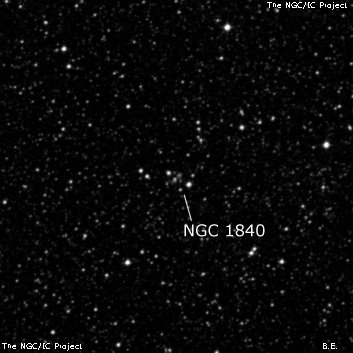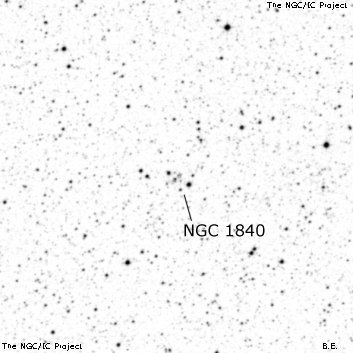NGC/IC Project Restoration Effort
(This is a very very beta version)
NGC1840


Basic Information
Location and Magnitude
Right Ascension: 5:5:19.2
Declination: -71:45:47
Constellation: MEN
Visual Magnitude:
Historic Information
Discoverer: Herschel J.
Year of discovery: 1834
Discovery aperture: 18.3
Observational
Summary description: F, R, bM, r (? min of RA)
Sub-type: OCL
Corwin's Notes
=====
NGC 1840 is probably a second observation of NGC 1833. Here is what I had to
say about this earlier:
JH saw this only once on 3 Nov 1834, and noted considerable
uncertainty about it: "F, R, bM, r. Hardly visible through a thick haze.
The observation makes the RA [05] 6m 13.5, but this is impossible from the
context. It *may* [JH's italics] be 8m." The haze must have cleared soon
after this observation as JH's notes on later objects in the same sweep make
no mention of it.
The position JH gives is 05 07 13.5, 161 58 26 (1830.0, NPD) -- there is
nothing there aside from field stars. Similarly at JH's "impossible"
position, there are only field stars. Close to the position implied if the
minutes of RA is 8, there is an asterism of four relatively bright stars with
half a dozen fainter. There is apparently a faint cluster here, ESO 056-SC062
= KMHK 529 (see Archinal and Hynes "Star Clusters" for more information).
Is this JH's object? It is usually taken to be NGC 1840, but I am not
convinced. First, the description -- even taking the "thick haze" into
account -- does not really fit the scattering of stars. Second, even if the
RA minute suggested by JH is correct, the position is still over 20 seconds of
time off. I don't see anything else in the area that JH would have called a
nebula, however, so the asterism is, by default, the best candidate. I've
checked at several of the positions implied by digit errors (+- 1 deg, +- 30
arcmin, etc), and see nothing obvious.
Jenni Kay, in her "Visual Atlas of the Magellanic Clouds" does not question
the identification of the asterism, and notes "... [it] may be only a few
stars in a group about 2.0 [arcmin] in size." She used a 12.5-inch reflector
at 150X for this observation. This does not sound like the same object that
JH recorded, but we have to remember that he was observing through "thick
haze".
I've put question marks on the identification.
-----
Going back over this in August 2016, I checked the sweep, where this is number
24. JH has scribbled in a note "Some mistake ? 9[min]". Unfortunately, in
the Herschel Archive, the minutes of the clock reading is partially lost in a
big smudge from the photocopy process: "[Something] 5". The remainder of the
observation is clear with the beat being "-20" and the wire being recorded as
"2". Assuming a wire error, 1 instead of 2, the RA would be 1m 35s more than
the recorded value; and if the edge of the field was meant, the RA would be
1m 26s less. Given all this, we can set up the following table of possible
RAs:
JH RA (1830) as given Wire 1, not 2 Field edge, not wire 2
05 06 13.5 05 07 48.5 05 04 47.5
05 07 13.5 05 08 48.5 05 05 47.5
05 08 13.5 05 09 48.5 05 06 47.5
05 09 13.5 05 10 48.5 05 07 47.5
Assumimg that JH's NPD is correct at 161 58 26, and we have our cluster on an
arc beginning at 05 02 17, -71 44.6 and ending at 05 08 14, -71 46.0 (both
J2000). Are there any clusters along that arc that match JH's description?
The only one is ESO 056-SC062, discussed above.
So, I returned to the sweep. I found that the nearest star in the sweep is
beta Mensa; JH has 05 04 56.1, 161 32 38 (1830, NPD) or 05 02 42.4, -71 18 51
(J2000), remarkably close to the Hipparcos position of 05 02 43.00,
-71 18 51.5. JH makes the cluster 25' 48" further south (for 1830) in his
reduced position, but 34' 10" by his NPD index reading (astute readers will
have already noticed that the sum of these two numbers is almost exactly one
degree; more on this below). So, there may be a declination error, too, as
this implies an NPD of 161 53 06 (1830), or -71 39.8 (J2000). There is
nothing obvious at this declination across the RAs in the table above.
I also noticed that NGC 1856 is the next object in the sweep. This is north
of beta Mensa, and the index reading is "00 22 05"; that for beta Men is
"02 35 00". Curiously, the index reading for NGC 1840 is "02 00 50", implying
that it too is north of beta Men. However, JH's reduced position has it
south. A check on this is JH's note at the beginning of the sweep
"P = 158[deg] 58[arcmin] + i" where P is the north polar distance and i is the
index recorded in the sweep. For beta Men (i = 02 35 00) and NGC 1856 (i =
00 22 05), the resulting NPDs are close to those that JH has given us. But
for NGC 1840, the NPD is a full degree off: NPD = 158 58 + 02 00 50 =
160 58 50 (1830). This becomes -70 45.6 for J2000.
Checking this arc, we find two candidate objects: NGC 1833 and SL 249 (at
05 07 35, -70 44.9). The NGC object (= h 2765) is the larger and brighter of
the two, and its position is off JH's by even digits: 1 minute of time, and 1
degree of declination. This makes it likely to also be NGC 1840. I've noted
that in the position table with colons. I've also put SL 249 into the table
as it is at the correct declination. Given JH's uncertainty about the RA,
this fainter cluster remains a possibility.
Steve's Notes
=====
NGC 1840
30" (10/15/15 - OzSky): NGC 1840 may the asterism of four mag 13.7-14.7 stars within 1.4' at this position. In addition a couple of mag 15-16 stars were resolved at 394x. Situated in a sparsely populated field.
More likely, though, NGC 1840 is a duplite of NGC 1833.



